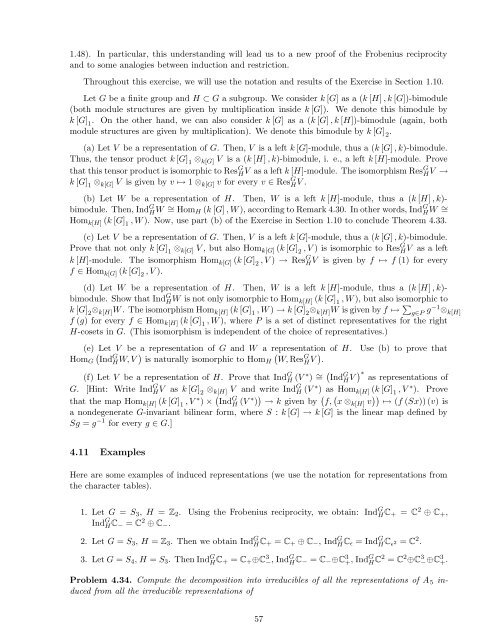Lecture notes for Introduction to Representation Theory
Lecture notes for Introduction to Representation Theory
Lecture notes for Introduction to Representation Theory
Create successful ePaper yourself
Turn your PDF publications into a flip-book with our unique Google optimized e-Paper software.
1.48). In particular, this understanding will lead us <strong>to</strong> a new proof of the Frobenius reciprocity<br />
and <strong>to</strong> some analogies between induction and restriction.<br />
Throughout this exercise, we will use the notation and results of the Exercise in Section 1.10.<br />
Let G be a finite group and H → G a subgroup. We consider k [G] as a (k [H] , k [G])-bimodule<br />
(both module structures are given by multiplication inside k [G]). We denote this bimodule by<br />
k [G] 1<br />
. On the other hand, we can also consider k [G] as a (k [G] , k [H])-bimodule (again, both<br />
module structures are given by multiplication). We denote this bimodule by k [G] 2<br />
.<br />
(a) Let V be a representation of G. Then, V is a left k [G]-module, thus a (k [G] , k)-bimodule.<br />
Thus, the tensor product k [G] 1 k[G] V is a (k [H] , k)-bimodule, i. e., a left k [H]-module. Prove<br />
that this tensor product is isomorphic <strong>to</strong> Res G<br />
H V as a left k [H]-module. The isomorphism ResG H V ⊃<br />
k [G] is given by v ⊃ 1 k[G] v <strong>for</strong> every v Res G<br />
1<br />
k[G] V H V .<br />
(b) Let W be a representation of H. Then, W is a left k [H]-module, thus a (k [H] , k)<br />
bimodule. Then, Ind G H W = ∪ Hom H (k [G] , W ), according <strong>to</strong> Remark 4.30. In other words, Ind G H W = ∪<br />
Hom k[H] (k [G] 1<br />
, W ). Now, use part (b) of the Exercise in Section 1.10 <strong>to</strong> conclude Theorem 4.33.<br />
(c) Let V be a representation of G. Then, V is a left k [G]-module, thus a (k [G] , k)-bimodule.<br />
Prove that not only k [G] 1<br />
k[G] V , but also Hom k[G] (k [G] 2<br />
, V ) is isomorphic <strong>to</strong> Res G<br />
H V as a left<br />
k [H]-module. The isomorphism Hom k[G] (k [G] 2<br />
, V ) ⊃ Res G<br />
H V is given by f ⊃ f (1) <strong>for</strong> every<br />
f Hom k[G] (k [G] 2<br />
, V ).<br />
(d) Let W be a representation of H. Then, W is a left k [H]-module, thus a (k [H] , k)<br />
bimodule. Show that Ind G<br />
H W is not only isomorphic <strong>to</strong> Hom k[H] (k [G] 1<br />
, W ), but also isomorphic <strong>to</strong><br />
k [G] 2<br />
k[H] W . The isomorphism Hom k[H] (k [G] 1<br />
, W ) ⊃ k [G] 2<br />
k[H] W is given by f ⊃ ⎨ gP g−1 k[H]<br />
f (g) <strong>for</strong> every f Hom k[H] (k [G] 1<br />
, W ), where P is a set of distinct representatives <strong>for</strong> the right<br />
H-cosets in G. (This isomorphism is independent of the choice of representatives.)<br />
(e)<br />
⎩<br />
Let V be a representation of G and W a representation<br />
⎩<br />
of H. Use (b) <strong>to</strong> prove that<br />
Hom G Ind<br />
G<br />
W, Res<br />
G<br />
H W, V is naturally isomorphic <strong>to</strong> Hom H H V .<br />
(f) Let V be a representation of H. Prove that Ind G = H V ⊕<br />
H (V ⊕ ) ∪ ⎩ Ind G as representations of<br />
G. [Hint: Write Ind G H V as k [G] 2<br />
k[H] V and write IndG H (V ⊕ ) as Hom k[H] (k [G] 1<br />
, V ⊕ ). Prove<br />
that the map Hom k[H] (k [G] 1<br />
, V ⊕ ⎩<br />
) H (V ⊕ ) ⊃ k given by ⎩ f, ⎩ x k[H] v Ind<br />
G<br />
×<br />
⊃ (f (Sx)) (v) is<br />
a nondegenerate G-invariant bilinear <strong>for</strong>m, where S : k [G] ⊃ k [G] is the linear map defined by<br />
Sg = g −1 <strong>for</strong> every g G.]<br />
4.11 Examples<br />
Here are some examples of induced representations (we use the notation <strong>for</strong> representations from<br />
the character tables).<br />
1. Let G = S = Using the Frobenius reciprocity, we obtain: Ind G = C 2<br />
3 , H Z 2 . H C + C + ,<br />
Ind G H C − = C 2 C − .<br />
2. Let G = S 3 , H = Z 3 . Then we obtain IndH G C + = C , Ind G + C − H C ρ = IndH G C ρ 2 = C2 .<br />
3. Let G = S 4 , H = S 3 . Then IndH G C + = C − , IndG − = C − C 3 H C2 = C 2 − C + 3 + C 3 H C + , IndG C 3 .<br />
Problem 4.34. Compute the decomposition in<strong>to</strong> irreducibles of all the representations of A 5 induced<br />
from all the irreducible representations of<br />
57

















